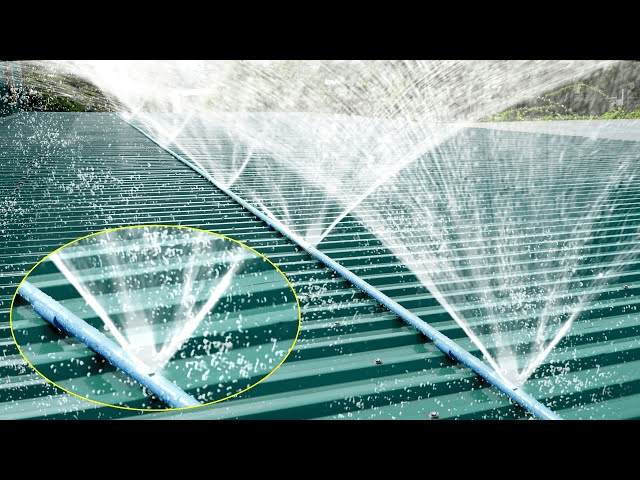Cooling your home during hot summer months can be challenging, especially if you’re looking for cost-effective and eco-friendly solutions. One idea that has sparked curiosity is: “Will putting a sprinkler on the roof cool the house?” This article explores the science behind this concept, its benefits, potential drawbacks, and alternatives to help you make an informed decision.

Understanding the Science: Can Sprinklers Really Cool Your Roof?
The theory behind using a sprinkler to cool your roof is rooted in basic physics. Water has a natural cooling effect due to its ability to absorb heat as it evaporates. Here’s how it works:
- Evaporative Cooling: When water from the sprinkler lands on the roof, it absorbs heat from the roof surface. As the water evaporates, it takes this heat away, lowering the roof’s temperature.
- Reduced Heat Transfer: A cooler roof translates to less heat being transferred into your home, potentially reducing indoor temperatures.
However, the effectiveness of this method depends on several factors, such as the type of roof, climate, and the amount of water used.
Read too: Hail Damage Roof Repair: Essential Guide to Restoring Your Home’s Protection
Will Putting A Sprinkler On The Roof Cool The House Effectively?
To answer the question, “Will putting a sprinkler on the roof cool the house?”, let’s evaluate its practicality and efficiency.
1. Benefits of Using a Sprinkler for Roof Cooling
- Immediate Cooling Effect: Sprinklers provide a quick way to reduce roof temperatures, especially during peak heat hours.
- Cost-Effective Solution: If you already have a sprinkler system, this method might be a low-cost cooling option compared to air conditioning.
- Eco-Friendly Approach: Using water for cooling is more environmentally friendly than relying on energy-intensive cooling systems.
2. Limitations and Challenges
- Water Waste: Using sprinklers can lead to significant water wastage, particularly in areas with water restrictions or drought conditions.
- Roof Damage Risk: Excessive water exposure can weaken certain roofing materials over time, leading to leaks or structural issues.
- Limited Impact on Indoor Temperature: While the roof may feel cooler, the reduction in indoor temperature may not be substantial enough to eliminate the need for air conditioning.
Factors to Consider Before Installing a Sprinkler System for Cooling
If you’re considering this method, keep the following factors in mind:
1. Type of Roof Material
- Metal Roofs: Metal surfaces cool quickly when exposed to water, making sprinklers effective.
- Asphalt Shingles: Prolonged exposure to water can damage shingles, reducing their lifespan.
- Clay or Tile Roofs: These materials are more water-resistant, but constant wetting may still lead to mold or algae growth.
2. Local Climate
This method works best in hot and dry climates where evaporative cooling is most effective. In humid areas, the evaporation process slows down, reducing the cooling effect.
3. Water Availability
If you live in a region with limited water resources, using a sprinkler for cooling may not be a sustainable option.
4. Maintenance Requirements
Regular maintenance of the sprinkler system and roof is essential to prevent issues such as clogged nozzles, water pooling, or roof damage.
Alternative Cooling Methods to Consider
While sprinklers can offer temporary relief, there are other methods to keep your home cool more efficiently:
1. Reflective Roof Coatings
Applying a reflective coating to your roof can reduce heat absorption and lower indoor temperatures.
2. Roof Insulation
Proper insulation minimizes heat transfer, keeping your home cooler in the summer and warmer in the winter.
3. Ventilation Systems
Improving attic ventilation helps release hot air trapped under the roof, reducing overall heat buildup.
4. Green Roofs
Planting vegetation on your roof provides natural insulation and cooling, while also being eco-friendly.
5. Solar Panels
Installing solar panels can not only reduce heat absorption but also provide renewable energy for your cooling needs.
How to Maximize Roof Cooling Efficiency
If you decide to use sprinklers for roof cooling, follow these tips to enhance their effectiveness:
1. Use Timers
Set timers to run the sprinklers during the hottest parts of the day, such as late morning and early afternoon.
2. Optimize Water Distribution
Ensure the sprinkler system covers the entire roof surface evenly for consistent cooling.
3. Combine With Other Cooling Methods
Pair sprinklers with reflective coatings or insulation to amplify the cooling effect.
4. Monitor Water Usage
Keep track of water consumption to avoid unnecessary waste and ensure sustainable usage.
Environmental and Economic Considerations
While sprinklers can be a cost-effective cooling solution, it’s essential to weigh their environmental and financial implications:
1. Water Usage and Sustainability
Using water for roof cooling may not be sustainable in regions facing water scarcity. Consider rainwater harvesting systems to offset usage.
2. Long-Term Costs
Frequent use of sprinklers may increase your water bills. Additionally, potential roof damage from prolonged water exposure could lead to costly repairs.
3. Energy Savings
While sprinklers may reduce the need for air conditioning, the overall energy savings depend on factors like roof type and local climate.
Will Putting A Sprinkler On The Roof Cool The House? Final Thoughts
To sum up, “Will putting a sprinkler on the roof cool the house?” The answer is yes, but with limitations. While sprinklers can provide immediate relief from heat, their effectiveness and sustainability depend on several factors, such as roof material, local climate, and water availability. For a more permanent and efficient solution, consider combining this method with other cooling strategies like reflective coatings, insulation, or ventilation systems.
Investing in sustainable cooling methods not only ensures a comfortable living environment but also helps reduce your environmental impact in the long run.



Leave a Reply